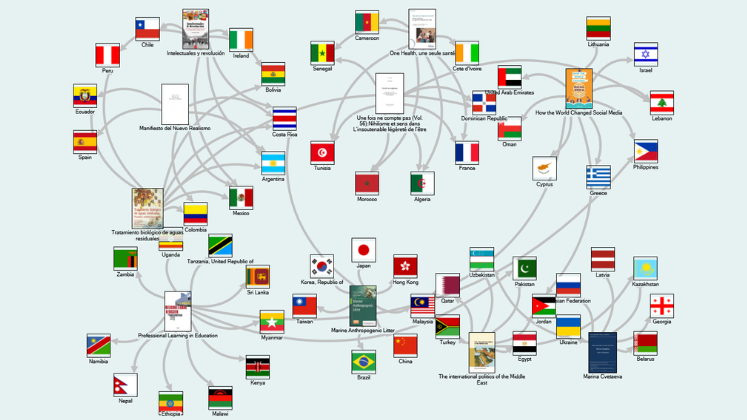English is often claimed as the international language of research and academia. However, important bibliodiverse scholarly traditions exist across the globe. Shubhada Nagarkar describes the UGC-CARE project and how efforts to list and record social science and humanities scholarly traditions in India, highlight the shifting boundaries of knowledge production in the country.
Research published in languages other than English (vernacular journals) in print and print+online journals has significant influence around the world, but particularly in India. Yet, despite their wealth of content, journals in vernacular languages struggle to gain visibility. This is an acute problem for publications in the Arts, Humanities, and Social Sciences (AHSS), because many of these journals are exclusively published in print. Bringing greater attention to this work has thus been the focus of efforts by the University Grants Commission of India (UGC) and its project to compile a Reference List of quality journals, the UGC-CARE project. This work, however raises particular issues around inclusion and exclusion and the rise of predatory publishing practices that cast a wider light on the politics of AHSS publishing and its importance to Indian academia.
In India, with its multiplicity of local languages, various difficulties and challenges arise in publishing research in the areas of AHSS and Indian Knowledge Systems (IKS). In fields such as cultural studies, literature, history, religious studies, drama, music, civilisation and yoga, Ayurveda and spiritual studies, researchers prefer to disseminate their findings in their native languages. India also has a long history of print periodicals (newspapers/magazines/journals) primarily in Indian languages.
it is predominantly those that publish in English that have gained international recognition and found place in international databases.
This tradition endures to this day, and many universities, learned societies, and local publishers continue to publish journals in regional languages. Since the 1950s, the number of journals published by Sahitya Academies, various Indian Councils (Indian Council of Historical Research (ICHR), Indian Council of Social Science Research (ICSSR), Indian Council of Philosophical Research (ICPR), Indian Council of Medical Research (ICMR) etc.), ministries, and universities has increased. Although, it is predominantly those that publish in English that have gained international recognition and found place in international databases.
Since 2010 and the implementation of the Academic Performance Appraisal (API) scheme by UGC, faculty members have been experiencing growing pressure to “publish or perish”. As a result, there has been a surge in the number of research journals. Unfortunately, this has also led to the proliferation of predatory publishing practices, making it difficult for new researchers to identify credible journals. It is in this context that the UGC took steps to address this issue through the Consortium of Academic and Research Ethics (CARE) initiative established in 2018, which aims to compile a “UGC-CARE Reference List of Quality Journals”. This includes journals published in various Indian languages especially in the fields of AHSS and IKS. This effort has gained global attention as a means of combating predatory publishing practices.
The list is classified into two groups – Group I: Journals found qualified through UGC-CARE protocols and Group II: Journals indexed in globally recognized databases – Web of Science, Scopus and the Directory of the Modern Language Association.
Publishers of vernacular journals face several challenges, including the fact that their journals are not indexed in international databases.
Publishers of vernacular journals face several challenges, including the fact that their journals are not indexed in international databases. Coming from small publishing houses, such journals fail to fulfil the criteria for being indexed in these databases. However, the UGC-CARE initiative has been successful to a certain extent in collecting information about these journals and listing them among its Group I journals. To be included in this list, journals must fulfil UGC-CARE protocols (needing one-time registration to the website). To collect the information on various language journals, UGC-CARE has established four nodal centres in four geographical areas, i.e., Jawaharlal Nehru University (northern region), University of Hyderabad (southern region), M.S. University Baroda (western region) and Tezpur university (eastern region). Moreover, 25 different council members are also contributing to the list. A special cell (UGC cell for journal analysis) has been established at Savitribai Phule Pune University, Maharashtra, to compile a list, in co-ordination with the four nodal offices and council members. Empowered Committee members finalise the list.
The CARE List is the only list in India that not only maintains the list of credible journals, but is also updated quarterly. Unless the publishers maintain quality, journals are discontinued from the list and hence publishers are under pressure to maintain the quality of the journals.
The CARE List is the only list in India that not only maintains the list of credible journals, but is also updated quarterly.
Creating a list of credible journals poses an array of challenges, including difficulty in locating the journals, obtaining postal addresses, and obtaining print copies. The lack of funding makes it challenging to sustain the journals for an extended period. Identifying the credentials of editors can also be difficult. The main challenge, however, is identifying predatory journals that have gone viral. These journals mimic credible publications and publish cloned web versions of print journals in local languages. Identifying the original journal has become a daunting task. To address this issue, the UGC-CARE website maintains a list of cloned versions of journals in Group I and Group II. Additionally, UGC-CARE provides a Table of Contents service for over 190 journals to help identify the original publications.
Beyond questions of publication ethics and inclusion in databases, is that in case of print journals in Indian languages, the distinction between periodical, magazine and journal is not clear. Many critics, writers and commentators like Rahul Sankirtyayan, Khushwant Singh, Balchandra Nemade and others published their writings in Indian language periodicals and their works are now being recognized as classic works in their fields. Similarly, Indian knowledge systems have flourished in multiple forms, languages and formats, and an initiative to document these would be topical.
The UGC-CARE reference list of quality journals especially from group I is unique in India and has had considerable impact on the publishing ecosystem. After the inclusion of journals in Group I of the CARE List, predatory publishers frequently mimic authentic ones, especially print language journals. The UGC-CARE website plays a vital role by identifying and listing these cloned journals, alerting users to select original journals for paper submission, thus preventing submissions to cloned sources.
The very inclusion of journals in the UGC-CARE list has also become indicative of the quality of the journals, thereby enabling researchers to consider them as venues for their publication. It has also prompted publishers to create digital archives of their periodicals and journals, including the hitherto print-only journals. This is growing into a large resource for researchers.
The list has also gained global recognition and is acknowledged by various databases and cited in national and international publications. Aligned with India’s New National Education Policy (NEP) 2020, which promotes multilingualism, multidisciplinary teaching, and ethical values, the UGC-CARE list is set to be a key reference. It plays a vital role in supporting NEP’s principles of diversity, local context, and quality education in Indian languages.
The content generated on this blog is for information purposes only. This Article gives the views and opinions of the authors and does not reflect the views and opinions of the Impact of Social Science blog (the blog), nor of the London School of Economics and Political Science. Please review our comments policy if you have any concerns on posting a comment below.
Image Credit: Jason Leung via Unsplash.








Resp madam,
The article (Blog) is good and need of the day to express views. The connection of Indian languages and research and NEP is well narrated. Congrats for the UGC- CARE initiative. This is for AHSS subjects but I request you to have one more blog regarding Technical Education in India i.e. Engineering, Management, Pharmacy, Architecture and Design.
Dear sir/madam,
UGC CARE list is an important step towards curbing the menace of predatory publications, it has other limitations which we have discussed in our recent publications. The DOI of the article is give below.
There was no proper clear guidelines on what constitute scholarly journals and in the name of I dian knowledge system the list has many literary magazines as scholarly publications.
The names mentioned in the article- Rahul Sankrityana, Kushwant Singh and Balachandra Namde all are well known in the Indian literary world and have been recognized thier contributions. Just because they are cited in literary criticism one should not consider including popular magazines and literary magazines as scholarly publications.
More importantly the UGC CARE list is politically driven it has given undue importance to few languages and journals for instance Sanskrit. It has listed more that 30 sanskrit journals where as they population which speaks this language is very minute, on the other had Kannada, Malayalam, Tamil have less number of journals and population speaking these languages are running to crores of people. The list is very skewed to very few languages.
Dear Sir/Madam,
The UGC-CARE List gives more emphasis to Humanities and Social Sciences Journals and Journals published in Indian languages, there is very less representation of Indian Journals in Engineering, Management and other Technical streams. Even when Journals are submitted for evaluation after forwarded by the respective universities, Technical Journals are not given due diligence.